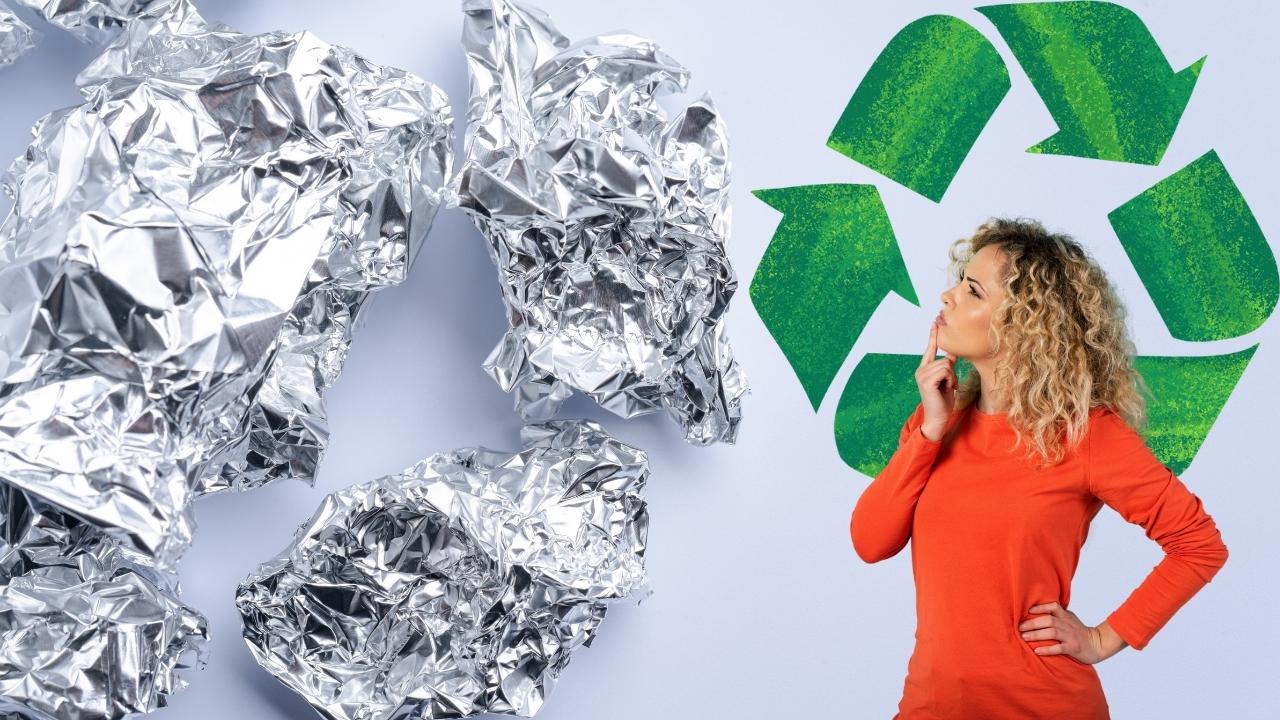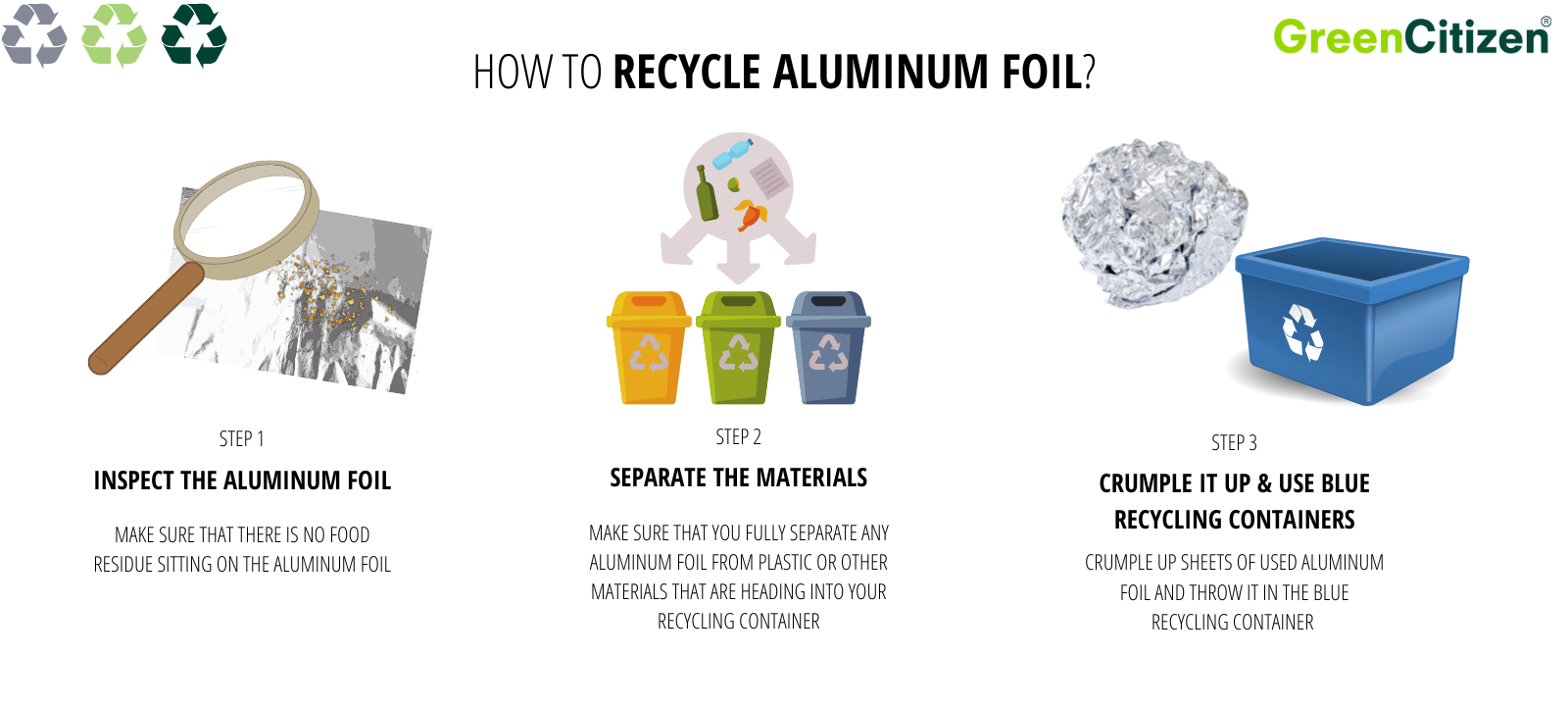Is aluminum foil recyclable? Yes and no! You can recycle “clean” aluminum foil but things get tricky if there is food residue on it. Learn more in this guide.

Recycling of aluminum cans has been one of the most successful parts of the circular economy, with an estimated 75% of all aluminum produced in the U.S. still being in use today. A lot of that comes down to services that pay the public to return their used aluminum, but many people don’t realize they can do something similar for aluminum foil.
You might have asked yourself, "is aluminum foil recyclable?"
When it comes to aluminum foil recycling, the process is a bit different, and there are also a few things you need to be aware of before you just place it in your recycling bin.
Let me explain.
Is Aluminum Foil Recyclable?
Yes, aluminum foil is fully recyclable as long as it’s not contaminated with food waste. While it’s often likely that your aluminum foil waste does have some food residue, you could simply wash it clean with your dishes to ensure it goes into the circular economy.
How To Recycle Aluminum Foil?
I mentioned above that aluminum soda cans are the most recycled materials in the U.S. and that 75% of all the aluminum produced is still in use. What’s even more amazing is that you can recycle aluminum indefinitely.
It simply doesn’t deteriorate, meaning that industries can make new aluminum products as long as we keep supplying them with our recycling waste.
But unlike cans, the recycling process for aluminum foil is a little bit different.
Here’s what you need to do.
1. Inspect The Aluminum Foil for Food Contamination
Once you’re finished with using a piece of tin foil, you’ll want to shake off any crumbs or other food into your trash. Then, once you're finished washing dishes, simply rinse them out to remove any other particles.
It’s important that the foil isn’t contaminated with food, as food and other materials can cause significant problems during the recycling processes.
Unfortunately, if the aluminum foil is heavily soiled with baked-in grease or cheese that you simply cannot get off easily, then it will need to go into your regular trash.
Keep that in mind when you use tin foil in food preparation to plan ahead for it to go into recycling.
2. Separate The Materials
Next up, make sure that you fully separate any aluminum foil from plastic or other materials that are heading into your recycling container.
Keeping it separate from other recyclables makes it a lot easier during manual and automated sorting processes and recycling plants.
That means pulling the aluminum fully off other container materials or trays. It’s a simple step that just improves the chances of it getting a second life.
Here’s why it’s important.
If you have mixed packaging that cannot be easily separated, then each of the materials will be classed as contaminated. The result is that the pre-sorting at the recycling facility will put it out, and it’ll most likely end up at a landfill.
It’s worth keeping in mind when you’re buying food. Don't just check if the packaging is recyclable, but also whether it’s easy to separate.
Read More:
3. Crumple It Up & Throw in the Blue "Recycling" Container
This might seem like an unnecessary step, but it’s important. If you just throw sheets of tin foil in your recycling bin, they will get caught up and tangled with other trash. Ultimately, that could contaminate the aluminum foil.
There’s also one further step.
Before you bring out your recycling bins, make sure that your regular curbside recycling programs accept aluminum foil. This isn’t always the case, and that would mean your foil ends up at the landfill.
You can also check our Green Directory for recycling centers and a materials recovery facility near you that would accept aluminum foil. Simply add your zip code and the type of recycling you need, and the results will give you the best and closest options.
How To Reuse Aluminum Foil?
Now, there is one thing that’s better than aluminum foil recycling, and that’s using the foil multiple times for different purposes. Reducing how much new aluminum you use has a huge impact on the carbon footprint of each sheet, even if you religiously recycle every bit of it.
Here are a few tips that you can follow to get some extra benefits out of aluminum foil.
1. Wash It For Alternative Uses
What most people don’t realize is that used tin foil is dishwasher safe. That means, the next time your dishwasher is full, simply add some aluminum foil that isn’t too heavily stained.
It won’t make sense to put in some foil that has baked in grease and cheese as that won’t come off.
But if you’ve simply wrapped some fruit or vegetables in some aluminum foil to keep it fresh, then cleaning it can be a simple way to reuse it.
The dishwasher will make it perfectly clean to get it through a few more uses before you need to recycle it.
2. Sharpen Scissors And Knives
This is one of those secret powers of tin foil. Because it’s a strong but light metal, it’s perfectly suitable for sharpening dull scissors.
Here’s what you need to do.
Flatten out a used piece of foil and then fold it over several times so that you have 4 to 6 layers. Then, use your scissors to cut through those layers a few times. The foil will gradually sharpen the edges of the scissors, and if you make this a regular habit, then you’ll avoid needing any other blade sharpener.
You can do something similar with knives.
Crumple up the foil into a ball and then create a v-shaped groove in the aluminum ball. Then, pull the blade of a knife through that groove and gradually cut through the aluminum. This polishes away damage and small dents in the metal blade to make it sharper.
3. Use It As A Scrubber
If you’ve ever battled with your BBQ grill after storing it for the winter, then you know how difficult it can be to get rid of all the leftover grease.
The great thing about a bundled-up ball of aluminum foil is that you can shape it into just the right size to get into all the corners. And the rough edges of the foil work amazingly well to get all the burnt-in grease off the metal.
I would suggest doing this primarily with those pieces of foil that cannot be easily recycled due to heavy soiling. Once you’re finished with cleaning your BBQ, it will need to go into your regular trash.
4. Polish Silverware
Here is another old trick that my grandmother showed me years ago. If you have some silverware at home, then you’ll know that it will regularly tarnish. And rather than use chemicals and a lot of manual work, there’s a small trick you can use.
Place the silverware directly on top of a used sheet of aluminum foil in a pot or a bowl. Then boil some water and mix in a few tablespoons of baking soda. The baking soda will foam up, and then it’s ready to gently pour over the silver.
It should only take a few minutes for the mix to lift the tarnish, and then you just need to wipe it clean.
5. Protect Garden Plants
You can take your used tin foil and wrap it around the base of your plants. It should almost look like you wrapped a shiny umbrella around the base.
And here’s what it will do.
First of all, the foil will reflect light up towards the leaves, which will increase the amount of photosynthesis. But that reflection will also mean that the ground doesn’t dry out as much.
And then there’s the added protection from pests. Many insects that could destroy your plants get to the leaves from the ground. With that added barrier, you’ll reduce a lot of those pests.
6. DIY Jobs
My final tip is to keep all those leftover pieces of aluminum foil that aren’t suitable for recycling and store them ready for your next home DIY painting jobs.
Rather than use plastic-based masking tape to cover door frames, light switches, and power sockets, use that foil to wrap them up instead. It offers much better protection from drips and spills, and you can get a perfectly straight edge with your paintbrush and roller.
So, instead of asking is aluminum foil recyclable, we all try to reuse it in our daily lives.
With a bit of creativity of course!
Read More:
FAQ: Recycling Aluminum Foil
Yes, you can recycle aluminum foil in your curbside bin, but you may need to verify this with the garbage collection company first. Not all companies have the facilities in place to handle aluminum.
No, you can’t recycle aluminum foil with food on it. If it’s just lightly soiled, then rinse it off when you’re cleaning your dishes, or put it in the dishwasher to get rid of the food waste first.
No, aluminum foil isn’t toxic, but it poses problems at landfills. Because it doesn’t rust or break down, it will remain as permanent waste at a landfill.
Yes, you can sometimes put aluminum foil in the recycling bin. But it’s important to first check with your recycling collection provider whether they have processes in place to separate and handle the aluminum.
Recycled aluminum foil can be made into ingots, which are essentially round or cylindrical shapes of aluminum. These can then be processed into new cans or foil, and it’s possible to repeat this process indefinitely.
No, aluminum cans are not biodegradable as aluminum will never break down. It’s important to bring aluminum cans to a recycling facility as this is the only way to ensure that the raw materials stay in the circular economy.
No, aluminum is not worse than plastic. While it may have a higher carbon footprint, recycling aluminum is an easy process. It’s possible to recycle the raw material indefinitely, which isn't possible with most types of plastic.
Are You Going To Change Your Habits For Aluminum Foil Recycling?
Take a few extra steps to ensure that less of your aluminum waste unnecessarily end up at a landfill. It’s just important to take a quick look at your used aluminum foil to see whether it’s clean enough to recycle.
If there’s just a small amount of food waste, then simply rinse it off with your dirty dishes or put it in the dishwasher to fully clean.
Then, check if your recycle bin service provider allows for aluminum. If not, use the Green Directory to find a local recycling program near you. It really is that easy to deal with light material like aluminum.












Now I understand how aluminum foil should be given care when thrown in the recycling bin since even a small amount of contamination will not make it eligible for the recycling programs. So I would take this knowledge and put this into practice every time I buy takeout with this kind of material. I also wondered if scrap metal companies accept these types.